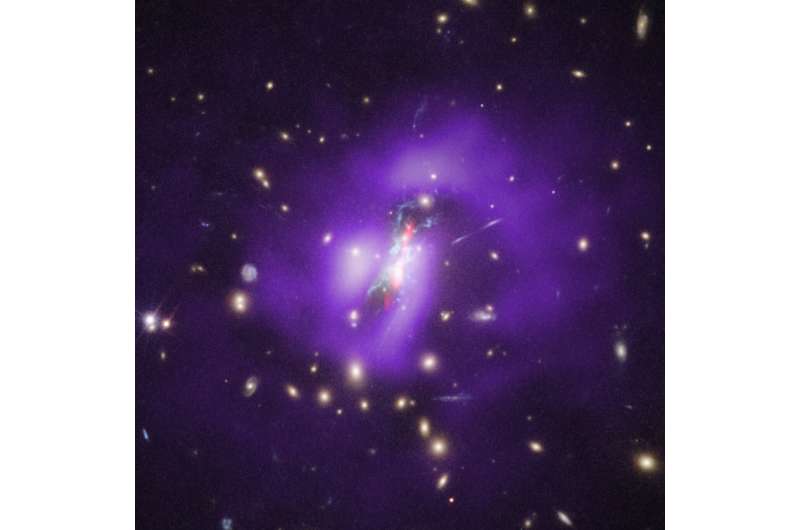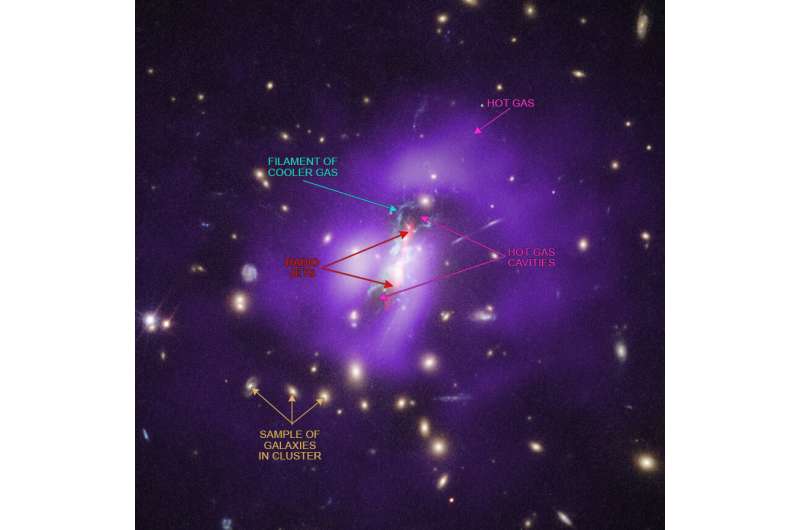Blowtorch jets from a black hole drive starbirth

Supermassive black holes, weighing millions or even billions of times our Sun's mass, are still only a tiny fraction of the mass of the galaxies they inhabit. But in some cases, the central black hole is the tail wagging the dog. It seems that black holes can run hot or cold when it comes to either enhancing or squelching star birth inside a cluster of galaxies.
Typically, giant black holes, pumping out energy via jets, keep interstellar gas too warm to condense and form stars. Now, astronomers have found a cluster of galaxies, called the Phoenix cluster, where stars are forming at a furious rate because of the black hole's influence. This stellar turboboost is apparently linked to less energetic jets from a central black hole that do not pump up the gas temperature. Instead, the gas loses energy as it glows in X-rays. The gas cools to where it can form large numbers of stars at a breathtaking rate. Where our Milky Way forms one star per year on average, newborn stars are popping out of this cool gas at a rate of about 500 solar masses per year in the Phoenix cluster.
Unraveling this mystery required the combined power of NASA's Hubble Space Telescope, NASA's Chandra X-ray Observatory, and the Very Large Array (VLA) radio observatory near Socorro, New Mexico.
The VLA radio data reveals jets blasting out from the vicinity of the central black hole. These jets inflated bubbles in the hot gas that are detected in X-rays by Chandra. Hubble resolves bright blue filaments of newborn stars in cavities between the hot jet and gas clouds. As the black hole has grown more massive and more powerful, its influence has been increasing.
Astronomers have confirmed the first example of a galaxy cluster where large numbers of stars are being born at its core. Using data from NASA space telescopes and a National Science Foundation radio observatory, researchers have gathered new details about how the most massive black holes in the universe affect their host galaxies.
Galaxy clusters are the largest structures in the cosmos that are held together by gravity, consisting of hundreds or thousands of galaxies embedded in hot gas, as well as invisible dark matter. The largest supermassive black holes known are in galaxies at the centers of these clusters.
For decades, astronomers have looked for galaxy clusters containing rich nurseries of stars in their central galaxies. Instead, they found powerful, giant black holes pumping out energy through jets of high-energy particles and keeping the gas too warm to form many stars.
Now, scientists have compelling evidence for a galaxy cluster where stars are forming at a furious rate, apparently linked to a less effective black hole in its center. In this unique cluster, the jets from the central black hole instead appear to be aiding in the formation of stars. Researchers used new data from NASA's Chandra X-ray Observatory and Hubble Space Telescope, and the NSF's Karl Jansky Very Large Array (VLA) to build on previous observations of this cluster.
"This is a phenomenon that astronomers had been trying to find for a long time," said Michael McDonald, astronomer at the Massachusetts Institute of Technology (MIT), who led the study. "This cluster demonstrates that, in some instances, the energetic output from a black hole can actually enhance cooling, leading to dramatic consequences."
The black hole is in the center of a galaxy cluster called the Phoenix Cluster, located about 5.8 billion light years from Earth in the Phoenix Constellation. The large galaxy hosting the black hole is surrounded by hot gas with temperatures of millions of degrees. The mass of this gas, equivalent to trillions of Suns, is several times greater than the combined mass of all the galaxies in the cluster.
This hot gas loses energy as it glows in X-rays, which should cause it to cool until it can form large numbers of stars. However, in all other observed galaxy clusters, bursts of energy driven by such a black hole keep most of the hot gas from cooling, preventing widespread star birth.
"Imagine running an air conditioner in your house on a hot day, but then starting a wood fire. Your living room can't properly cool down until you put out the fire," said co-author Brian McNamara of the University of Waterloo in Canada. "Similarly, when a black hole's heating ability is turned off in a galaxy cluster, the gas can then cool."
Evidence for rapid star formation in the Phoenix Cluster was previously reported in 2012 by a team led by McDonald. But deeper observations were required to learn details about the central black hole's role in the rebirth of stars in the central galaxy, and how that might change in the future.
By combining long observations in X-ray, optical, and radio light, the researchers gained a ten-fold improvement in the data quality compared to previous observations. The new Chandra data reveal that hot gas is cooling nearly at the rate expected in the absence of energy injected by a black hole. The new Hubble data show that about 10 billion solar masses of cool gas are located along filaments leading towards the black hole, and young stars are forming from this cool gas at a rate of about 500 solar masses per year. By comparison, stars are forming in the Milky Way galaxy at a rate of about one solar mass per year.

The VLA radio data reveal jets blasting out from the vicinity of the central black hole. These jets likely inflated bubbles in the hot gas that are detected in the Chandra data. Both the jets and bubbles are evidence of past rapid growth of the black hole. Early in this growth, the black hole may have been undersized, compared to the mass of its host galaxy, which would allow rapid cooling to go unchecked.
"In the past, outbursts from the undersized black hole may have simply been too weak to heat its surroundings, allowing hot gas to start cooling," said co-author Matthew Bayliss, who was a researcher at MIT during this study, but has recently joined the faculty at the University of Cincinnati. "But as the black hole has grown more massive and more powerful, its influence has been increasing."
The cooling can continue when the gas is carried away from the center of the cluster by the black hole's outbursts. At a greater distance from the heating influence of the black hole, the gas cools faster than it can fall back towards the center of the cluster. This scenario explains the observation that cool gas is located around the borders of the cavities, based on a comparison of the Chandra and Hubble data.
Eventually the outburst will generate enough turbulence, sound waves and shock waves (similar to the sonic booms produced by supersonic aircraft) to provide sources of heat and prevent further cooling. This will continue until the outburst ceases and the build-up of cool gas can recommence. The whole cycle may then repeat.
"These results show that the black hole has temporarily been assisting in the formation of stars, but when it strengthens its effects will start to mimic those of black holes in other clusters, stifling more star birth," said co-author Mark Voit of Michigan State University in East Lansing, Michigan.
The lack of similar objects shows that clusters and their enormous black holes pass through the rapid star formation phase relatively quickly.
A paper describing these results was published in a recent issue of The Astrophysical Journal, and a preprint is available online.
More information: M. McDonald et al. Anatomy of a Cooling Flow: The Feedback Response to Pure Cooling in the Core of the Phoenix Cluster, The Astrophysical Journal (2019). DOI: 10.3847/1538-4357/ab464c , arxiv.org/abs/1904.08942
Journal information: Astrophysical Journal
Provided by ESA/Hubble Information Centre




















